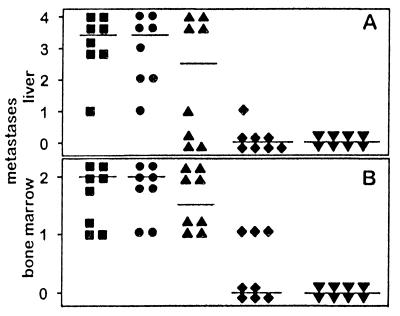Figure 3.
Effect of single chain IL-12-producing NXS2 cells on subsequent challenge with NXS2 parental cells. Syngeneic A/J mice (n = 8) were injected s.c. with low and intermediate scIL-12-producing NXS2 cell clones and subsequently challenged 7 days thereafter by i.v. injection of 5 × 104 NXS2 parental cells. Tumors were surgically removed 14 days after s.c. inoculation. After 26 days, mice were sacrificed and analyzed for liver (A) and bone marrow metastases (B). Horizontal lines represent the median of each experimental group. (A) Liver metastases were staged after s.c. injection with 2 × 106 low (▴) and either 2 × 106 (⧫) or 4 × 106 intermediate (▾) scIL-12-producing NXS2 cells according to the percent liver surface covered with metastatic lesions. 4 = >75%; 3 = 50–75%; 2 = 25–50%; 1= >0–25%; 0 = 0%. Results were compared with mice receiving no s.c. injection (▪) or injection with 4 × 106 NXS2 cells carrying only the empty vector (•). Differences between results with intermediate scIL-12-producing NXS2 cells and all control groups were statistically significant (P < 0.001). (B) Bone marrow metastases were analyzed by tyrosine hydroxylase RT-PCR and scored, as described in Materials and Methods, after s.c. injection of 2 × 106 low (▴) and either 2 × 106 (⧫) or 4 × 106 intermediate (▾) scIL-12-producing NXS2 cells and compared with control animals receiving no s.c. injection (▪) or injection with 4 × 106 NXS2 cells carrying only the empty vector (•). Differences between results with intermediate scIL-12-producing NXS2 cells and all control groups were statistically significant (P < 0.005).

